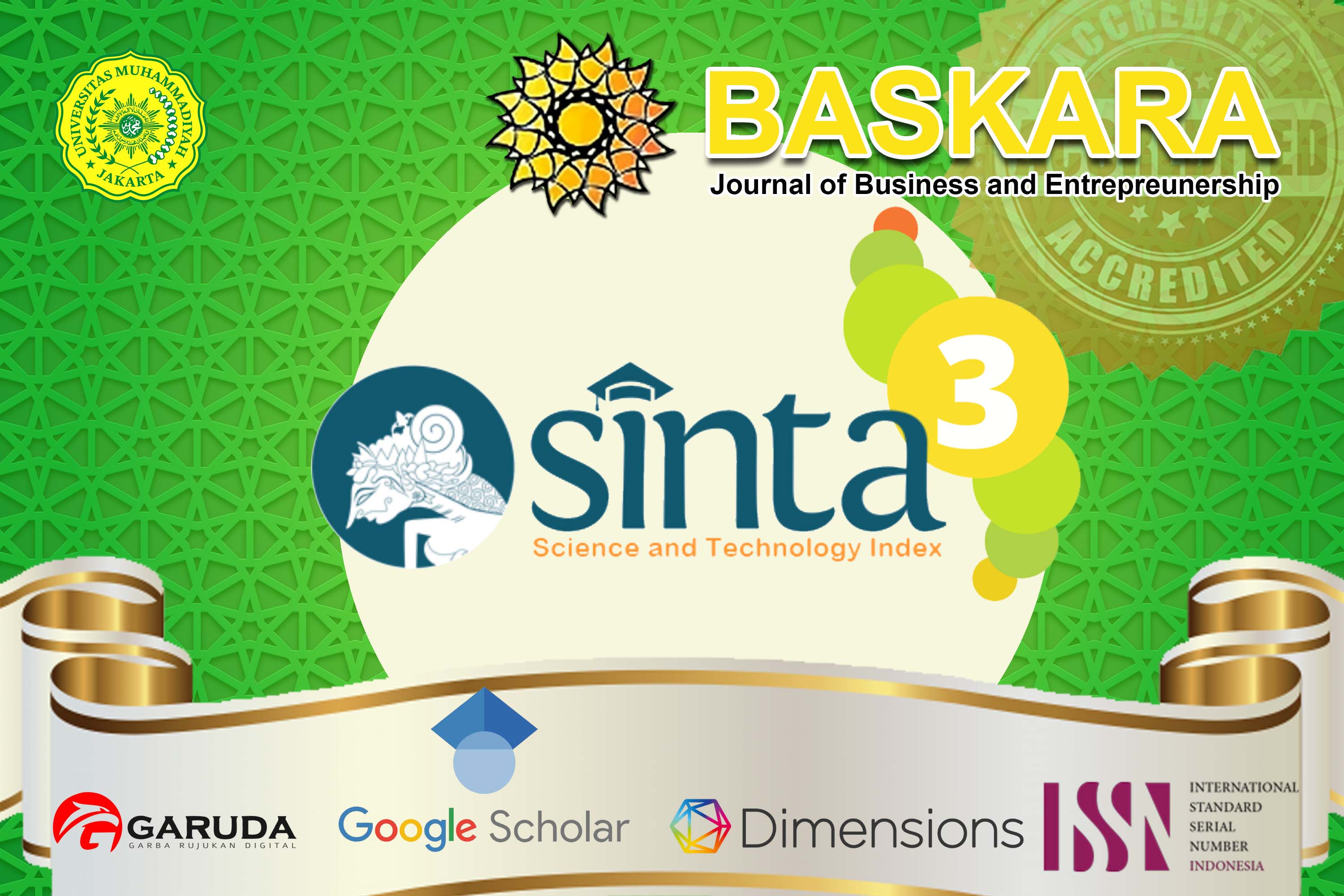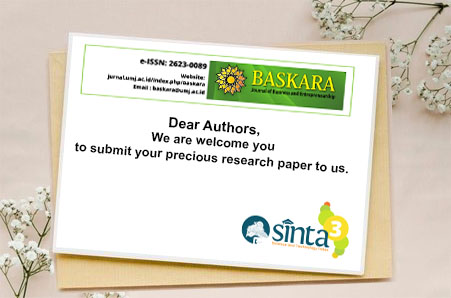An Examination of Business Performance: The Relationship and Its Relevance Factors
Abstract
Within the purview of influencing factors, due consideration is given to the adoption of technology and the role played by external assistance. Moreover, this study underscores the crucial function of business continuity as a mediating factor in this intricate equation and the moderating influence of employee creativity. The primary objective of this research is to delve into the multifaceted elements that exert influence on the overall success of small and medium businesses (SMEs). Employing a rigorous quantitative research approach, a carefully selected cohort of 109 respondents was drawn from the SME community. These respondents were sourced from the membership pool of a financial counseling group affiliated with PT. TASPEN (PERSERO), providing a comprehensive cross-section of perspectives and experiences. The insightful findings derived from this study corroborate the hypothesis that external assistance can indeed have a constructive impact on company performance. However, this influence is found to be channeled through the mediating role of SME business continuity, thus underscoring the importance of maintaining operational resilience and consistency. The research did not find conclusive evidence supporting a direct link between technological adoption and business success within the SME context, indicating that further investigation might be warranted to elucidate this relationship. Nonetheless, these findings provide valuable insights into the intricate web of factors influencing SME success and offer pertinent guidance for businesses aiming to thrive in an ever-evolving landscape.
Keywords
Full Text:
PDFReferences
Adam, N. A., & Alarifi, G. (2021a). Innovation practices for survival of small and medium enterprises (SMEs) in the COVID-19 times: the role of external support. Journal of Innovation and Entrepreneurship, 10(1). https://doi.org/10.1186/s13731-021-00156-6
Adam, N. A., & Alarifi, G. (2021b). Innovation practices for survival of small and medium enterprises (SMEs) in the COVID-19 times: the role of external support. Journal of Innovation and Entrepreneurship, 10(1). https://doi.org/10.1186/s13731-021-00156-6
Afolabi, B. (2012). An empirical evidence on the usage of internet marketing in the hospitality sector inn an emerging economy and its relationship to profitability. www.irssh.com
Ali, H., Hao, Y., & Aijuan, C. (2020). Innovation Capabilities and Small and Medium Enterprises’ Performance: An Exploratory Study. Journal of Asian Finance, Economics and Business, 7(10), 959–968. https://doi.org/10.13106/jafeb.2020.vol7.no10.959
Alraja, M. N., Imran, R., Khashab, B. M., & Shah, M. (2022). Technological Innovation, Sustainable Green Practices and SMEs Sustainable Performance in Times of Crisis (COVID-19 pandemic). Information Systems Frontiers, 24(4), 1081–1105. https://doi.org/10.1007/s10796-022-10250-z
Arianto Muditomo, & Indra Wahyudi. (2020). Conceptual Model for SME Digital Transformation during The Covid-19 Pandemic Time in Indonesia: R-Digital Transformation Model, 1(1), https://doi.org/10.54268/baskara.3.1.13-23
Aulia, M. R., Ph Saragi, C., & Simbolon, R. (2021). The Effect of Entrepreneurial Characteristics on Entrepreneurial Competence and Entrepreneurial Competence on Business Performance of Micro and Small-Scale Coffee Shops in Bogor.
Baldwin, N., Crawford Scottish Enterprise John Cridland, R., Dunnett, A., Gibson, M., Glover, A., Hughes, D., Kingman Treasury Ron Loveland Welsh Assembly Roger Lyons, J. H., Norris, G., Shiner, J., Taylor OST, J., Joe Tidd, D., & Whitfield, C. (2003). Policy Directorate Vicky Pryce Chief Economic Adviser, DTI (Issue 10).
Baregheh, A., Rowley, J., & Sambrook, S. (2009). Towards a multidisciplinary definition of innovation. Management Decision, 47(8), 1323–1339. https://doi.org/10.1108/00251740910984578
Byrne, B. M. (2001). Structural Equation Modeling With AMOS, EQS, and LISREL: Comparative Approaches to Testing for the Factorial Validity of a Measuring Instrument. International Journal of Testing, 1(1), 55–86. https://doi.org/10.1207/s15327574ijt0101_4
Chau, P. Y. K., & Tam, K. Y. (1997). Factors Affecting the Adoption of Open Systems: An Exploratory Study Adoption of Open Systems Factors Affecting the Adoption of Open Systems: An Exploratory Study1. In Source: MIS Quarterly (Vol. 21, Issue 1).
Chin, W. (2000). Association for Information Systems AIS Electronic Library (AISeL) Partial Least Squares for IS Researchers: An Overview and Presentation of Recent Advances Using the PLS Approach. http://aisel.aisnet.org/icis2000/88
Chittithaworn, C., Islam, A., Keawchana, T., & Yusuf, D. H. M. (2011). Factors affecting business success of small & medium enterprises (SMEs) in Thailand. Asian Social Science, 7(5), 180–190. https://doi.org/10.5539/ass.v7n5p180
Chiu, C.-Y., Chen, S., & Chen, C.-L. (2017). An integrated perspective of TOE framework and innovation diffusion in broadband mobile applications adoption by enterprises. Economics and Social Sciences (IJMESS) (IJMESS), 6(1), 14–39. http://hdl.handle.net/10419/157921http://creativecommons.org/licenses/by-nc/3.0/http://www.ijmess.com
Chrisman, J. J., & Mcmullan, W. E. (2004). Outsider Assistance as a Knowledge Resource for New Venture Survival. In Journal of Small Business Management (Vol. 42, Issue 3).
Cliff, J. E. (1996). Does One Size Fit All? Exploring The Relationship Between Attitudes Towards Growth, Gender and Business Size. In Ohio. Journal of Business Venturing (Vol. 13).
Csikszentmihalyi, M. (1988). MOTIVATION AND CREATIVITY: TOWARD A SYNTHESIS OF STRUCTURAL AND ENERGISTIC APPROACHES TO COGNITION*. New Ideas in Psychology, 6(2).
Danes, S. M., Loy, T.-C., & Stafford, K. (2008). Business Planning Practices of Family-Owned Firms within a Quality Framework*. In Journal of Small Business Management (Vol. 46, Issue 3).
de Brito, R. P., & Brito, L. A. L. (2014). Dynamics of competition and survival. BAR - Brazilian Administration Review, 11(1), 64–85. https://doi.org/10.1590/S1807-76922014000100005
Diansari, N. M. N., Riana, I. G., & Surya, I. B. K. (2021). Knowledge Sharing and Innovation in Small Medium Enterprises (SMEs) Moderated by Creative Leadership. Journal of Management Science & Engineering Research, 3(2), 39–45. https://doi.org/10.30564/jmser.v3i2.2615
Effendi, M. I., Sugandini, D., Istanto, Y., Arundari, R., & Adisti, T. (2020). The Technology-Organization-Environment Framework: ADOPSI TEKNOLOGI PADA UKM. https://www.researchgate.net/publication/345989050
Eveland, J., & Tornatzky, L. G. (1990). Technological Innovation as a Process. In The Processes of Technological Innovation.
Faisol, Suhardi, Astuti, P., & Subagyo. (2022). THE ADOPTION OF ICT TO IMPROVE THE PERFORMANCE OF SMES IN DIGITAL ERA. Proceeding 2nd International Conference on Business and Social Sciences (ICOBUSS).
Gefen, D., & Straub, D. (2005). A Practical Guide To Factorial Validity Using PLS-Graph: Tutorial And Annotated Example. Communications of the Association for Information Systems, 16. https://doi.org/10.17705/1cais.01605
Gimeno, J., Folta, T. B., Cooper, A. C., & Woo, C. Y. (1997). Survival of the Fittest? Entrepreneurial Human Capital and the Persistence of Underperforming Firms. In Source: Administrative Science Quarterly (Vol. 42, Issue 4). http://www.jstor.orgStableURL:http://www.jstor.org/stable/2393656Accessed:18/08/200812:10
Hair, J. F., Hult, G. T. M., Ringle, C. M., Sarstedt, M., Danks, N. P., & Ray, S. (2021). Partial Least Squares Structural Equation Modeling (PLS-SEM) Using R. Springer International Publishing. https://doi.org/10.1007/978-3-030-80519-7
Hidayati, R., & Rachman, N. M. (2021). INDONESIAN GOVERNMENT POLICY AND SMEs BUSINESS STRATEGY DURING THE COVID-19 PANDEMIC. Niagawan, 10(1).
Hult, G. T. M., Hurley, R. F., & Knight, G. A. (2004). Innovativeness: Its antecedents and impact on business performance. Industrial Marketing Management, 33(5), 429–438. https://doi.org/10.1016/j.indmarman.2003.08.015
Ifinedo, P. (2011). An empirical analysis of factors influencing internet/e-business technologies adoption by smes in Canada. International Journal of Information Technology and Decision Making, 10(4), 731–766. https://doi.org/10.1142/S0219622011004543
Jalil, M. F., Ali, A., & Kamarulzaman, R. (2022). Does innovation capability improve SME performance in Malaysia? The mediating effect of technology adoption. International Journal of Entrepreneurship and Innovation, 23(4), 253–267. https://doi.org/10.1177/14657503211048967
Jogiyanto. (2011). Konsep dan aplikasi structural equation modeling berbasis varian dalam penelitian bisnis. UPP STIM YKPN.
Kalleberg, A. L., & Leicht, K. T. (1986). Jobs and Skills: A Multivariate Structural Approach.
Lo, F. Y. (2016). Factors leading to foreign subsidiary ownership: A multi-level perspective. Journal of Business Research, 69(11), 5228–5234. https://doi.org/10.1016/j.jbusres.2016.04.117
Mahmudova, L., & Kovács, J. K. (2018). Definiting The Performance of Small and Medium Enterprises. Network Intelligence Studies, VI(12).
Mason, C., & Brown, R. (2013). Creating good public policy to support high-growth firms. Small Business Economics, 40(2), 211–225. https://doi.org/10.1007/s11187-011-9369-9
Muna Almaududi Ausat, A. (2021). Obstacles and Solutions of MSMEs in Electronic Commerce during Covid-19 Pandemic: Evidence from Indonesia. Jl. RA. Kartini KM, 3(163). https://avantifontana.com
Muñoz-Pascual, L., Galende, J., & Curado, C. (2021). Contributions to sustainability in smes: Human resources, sustainable product innovation performance and the mediating role of employee creativity. Sustainability (Switzerland), 13(4), 1–20. https://doi.org/10.3390/su13042008
Piaralal, S. K., Nair, S. R., Yahya, N., & Karim, J. A. (2015). An Integrated Model of the Likelihood and Extent of Adoption of Green Practices in Small and Medium Sized Logistics Firms. American Journal of Economics, 2015(2), 251–258. https://doi.org/10.5923/c.economics.201501.32
Prause, M. (2019). Challenges of Industry 4.0 technology adoption for SMEs: The case of Japan. Sustainability (Switzerland), 11(20). https://doi.org/10.3390/su11205807
Raisch, S., & Birkinshaw, J. (2008). Organizational ambidexterity: Antecedents, outcomes, and moderators. In Journal of Management (Vol. 34, Issue 3, pp. 375–409). https://doi.org/10.1177/0149206308316058
Rauch, A., Wiklund, J., Lumpkin, G. T., & Frese, M. (2009). Entrepreneurial orientation and business performance: An assessment of past research and suggestions for the future. Entrepreneurship: Theory and Practice, 33(3), 761–787. https://doi.org/10.1111/j.1540-6520.2009.00308.x
Razak, D. A., Abdullah, M. A., & Ersoy, A. (2018). SMALL MEDIUM ENTERPRISES (SMES) IN TURKEY AND MALAYSIA A COMPARATIVE DISCUSSION ON ISSUES AND CHALLENGES. International Journal of Business, Economics and Law, 15(3).
Rocha, M., Searcy, C., & Karapetrovic, S. (2007). Integrating sustainable development into existing management systems. In Total Quality Management and Business Excellence (Vol. 18, Issues 1–2, pp. 83–92). https://doi.org/10.1080/14783360601051594
Sternberg, R. J. (2006). The Nature of Creativity.
Storey, D. J., Saridakis, G., Sen-Gupta, S., Edwards, P. K., & Blackburn, R. A. (2010). Linking HR formality with employee job quality: The role of firm and workplace size. Human Resource Management, 49(2), 305–329. https://doi.org/10.1002/hrm.20347
Taques, F. H., López, M. G., Basso, L. F., & Areal, N. (2021). Indicators used to measure service innovation and manufacturing innovation. Journal of Innovation and Knowledge, 6(1), 11–26. https://doi.org/10.1016/j.jik.2019.12.001
Tien, N. Van. (2022). Recommendations Enhancing the Competitive Capacity of Small and Medium Enterprises after the Covid-19 Pandemic. Emerging Science Journal, 6(Special Issue), 122–135. https://doi.org/10.28991/esj-2022-SPER-09
Windolph, S. E., Harms, D., & Schaltegger, S. (2014). Motivations for corporate sustainability management: Contrasting survey results and implementation. Corporate Social Responsibility and Environmental Management, 21(5), 272–285. https://doi.org/10.1002/csr.1337
Yıldız, S., Baştürk, F., & Boz, İ. T. (2014). The Effect of Leadership and Innovativeness on Business Performance. Procedia - Social and Behavioral Sciences, 150, 785–793. https://doi.org/10.1016/j.sbspro.2014.09.064
Zhou, J., & Shalley, C. E. (2003). RESEARCH ON EMPLOYEE CREATIVITY: A CRITICAL REVIEW AND DIRECTIONS FOR FUTURE RESEARCH. In Research in Personnel and Human Resources Management (Vol. 22, pp. 165–217). JAI Press. https://doi.org/10.1016/S0742-7301(03)22004-1
Zhu, Q., Zou, F., & Zhang, P. (2019). The role of innovation for performance improvement through corporate social responsibility practices among small and medium-sized suppliers in China. Corporate Social Responsibility and Environmental Management, 26(2), 341–350. https://doi.org/10.1002/csr.1686
Zuhdi, Suharjo, B., & Sumarno, H. (2016). PERBANDINGAN PENDUGAAN PARAMETER KOEFISIEN STRUKTURAL MODEL MELALUI SEM. Journal of Mathematics and Its Applications, 15(2).
DOI: https://doi.org/10.54268/baskara.v6i1.16687
Refbacks
- There are currently no refbacks.
Copyright (c) 2023 BASKARA : Journal of Business and Entrepreneurship
BASKARA: Journal of Business and Entrepreneurship Copyright of Baskara: Journal of Business and Entrepreneurship (e-ISSN: 2623-0089 ). This work is licensed under a Creative Commons Attribution-NonCommercial 4.0 International License |
















